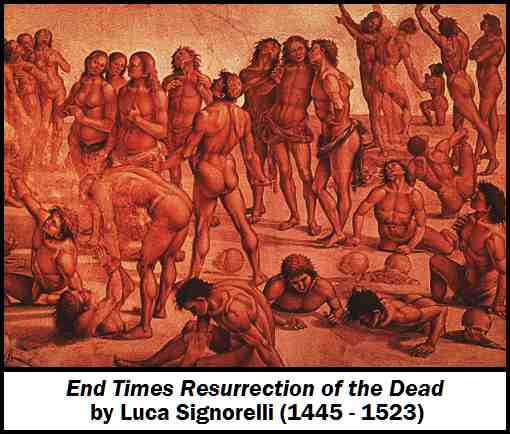
The Resurrection of the Dead Saints
Readers of the gospels are often puzzled by a short passage at Matthew 27:52-53, which comes just after the description of Jesus' death on the cross. The passage reads as follows:
The tombs broke open and the bodies of many holy people who had died were raised to life. They came out of the tombs, and after Jesus' resurrection they went into the holy city and appeared to many people.
The passage says that some dead holy people returned to life and came out of their tombs, then went into Jerusalem, where many inhabitants of the city saw them. Because the King James translation refers to these resurrected people as "saints", this event is sometimes called "the resurrection of the dead saints".
Matthew 27:51 indicates that an earthquake occurred just as Jesus died, and that this earthquake was what opened the tombs of these saints. But although they returned to life immediately, they apparently didn't go into Jerusalem until at least two days later, or no earlier than the first Easter Sunday.
The resurrection of these dead bodies obviously wasn't an ordinary event. In fact it was clearly a divine action. God could have brought it about directly, or he could have simply created the conditions that finally gave rise to it. Some people have suggested that the final trigger was a supernatural power that emanated from Jesus as he died on the cross.
Scholars have looked for reports of this resurrection in other ancient writings, but no definite references to it have been found. However, some scholars do see a possible connection to ancient prophecies about a resurrection of dead saints expected to occur during the End Times. The prophesies say that all dead saints will return to life at that time so that they can take their place in a newly-created eternal Kingdom of God. It has been suggested that the resurrection described in Matthew's passage was a "preview" of this predicted end-times resurrection.
Note: The image shows an artist's depiction of the universal resurrection predicted to take place during the End Times.
Another possible explanation for Matthew's passage relates it to a story known as the "Harrowing of Hell". According to this story, which is mentioned in the Apostles' Creed, after Jesus died on the cross he descended to Hell and rescued the souls of all the ancient dead saints from their imprisonment there. After these rescued souls left Hell, they could have returned to their old bodies in the tombs and brought them back to life. But if this is what happened, it must have taken place very quickly, because Matthew says that the saints were resurrected almost immediately after Jesus died.
Who Were These Resurrected Saints?
All of these resurrected saints were apparently buried in the vicinity of Jerusalem. Nothing is said about any dead saints who were buried elsewhere. The passage also doesn't identify any of the resurrected saints by name, but some later Christian writers speculated about who they might be. The suggested possibilities included Adam and Eve, Abel, Abraham, Isaiah, and various other Old Testament figures. Because the earliest followers of Jesus still considered themselves to be Jews, they would have regarded these Old Testament figures as saints.
Matthew also doesn't say what these resurrected saints did after they were seen in Jerusalem. Modern readers often assume that they went back to their tombs and died again. Such a temporary resurrection could still serve as a preview of the general resurrection prophesied for the End Times. However, the passage doesn't say that they died again, so other possibilities should be considered. Of course they probably aren't still alive on the earth somewhere. Perhaps the most likely remaining possibility is that they eventually ascended to heaven.
Were These People Really Resurrected?
The other three gospels don't mention the resurrection of these saints. Partly for this reason, many biblical scholars doubt that it really happened. They argue that such an extraordinary event, if it really occurred, would provide strong evidence for the divinity of Jesus, and therefore the other gospel writers would have also described it.
Another reason for doubt is that these resurrected saints would have created a lot of excitement when they appeared in Jerusalem, and a historian like Josephus, who wrote a detailed account of the period, probably would have said something about it. But he doesn't mention it at all.
For these reasons, many scholars believe that Matthew's passage describes a legendary story rather than a real event. It might be similar to a modern "urban legend". Of course, this raises the question of how such a story could have originated.
According to one theory, the story originated in the days immediately after the resurrection of Jesus. This would have been a time of great excitement for his followers. They believed that he was the long-awaited Messiah, and that he had come to establish a new eternal Kingdom of God on the earth. Buoyed by their high expectations, they could have regarded his resurrection as a "signal" that this new kingdom was about to be created. They could have even been looking for signs that it was beginning to appear.
One such sign would be the resurrection of the ancient dead saints. Perhaps some of Jesus' followers thought they saw resurrected saints walking around in Jerusalem during this period. If so, the original reports of these sightings might have survived in the form of a legendary story. And this legendary story might be what is preserved in Matthew's passage.
Note: Under normal circumstances, a dead body will eventually decompose to the point that its individual features are no longer recognizable. But many early Christians believed that the body of a true holy person is incorruptible, so that it doesn't decay at all, but is miraculously preserved for its eventual resurrection. This explains how long-dead saints could return to life in their original bodies.
Other Topics
Contact Email



